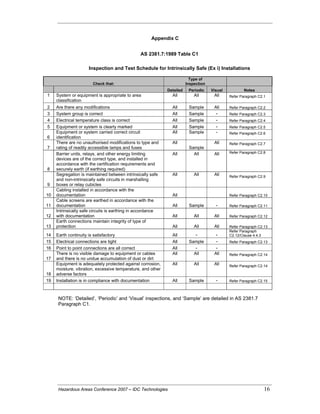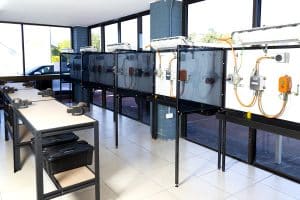An Unbiased View of Roar Solutions
Wiki Article
All About Roar Solutions
Table of ContentsThe Facts About Roar Solutions Revealed9 Easy Facts About Roar Solutions ShownHow Roar Solutions can Save You Time, Stress, and Money.
In order to secure setups from a prospective explosion a technique of analysing and categorizing a possibly unsafe area is needed. The function of this is to guarantee the appropriate selection and installation of equipment to inevitably stop an explosion and to ensure safety of life.
(https://www.slideshare.net/thomascarrillo4740)
No tools ought to be installed where the surface area temperature of the devices is better than the ignition temperature level of the offered threat. Below are some typical dust hazardous and their minimal ignition temperature. Coal Dust 380C 225C Polythene 420C (thaws) Methyl Cellulose 420C 320C Starch 460C 435C Flour 490C 340C Sugar 490C 460C Grain Dirt 510C 300C Phenolic Material 530C > 450C Aluminium 590C > 450C PVC 700C > 450C Residue 810C 570C The likelihood of the danger being present in a focus high sufficient to trigger an ignition will vary from area to area.
Dangerous location electrical tools maybe designed for usage in greater ambient temperatures. Area Repair By Authorised Personnel: Complex testing might not be needed however particular procedures might require to be complied with in order for the equipment to maintain its 3rd celebration score. Each piece of devices with an unsafe rating must be examined separately.
8 Easy Facts About Roar Solutions Described
The equipment register is a comprehensive database of devices records that includes a minimum collection of areas to recognize each thing's place, technical criteria, Ex category, age, and environmental information. This information is crucial for tracking and handling the tools successfully within harmful locations. On the other hand, for periodic or RBI tasting assessments, the quality will be a combination of Detailed and Close examinations. The ratio of Comprehensive to Shut assessments will be established by the Devices Threat, which is assessed based on ignition threat (the chance of a source of ignition versus the chance of a flammable atmosphere )and the harmful location classification( Area 0, 1, or 2). This variation will certainly additionally influence the resourcing demands for job prep work. Once Lots are defined, you can establish sampling plans based upon the example size of each Whole lot, which describes the variety of arbitrary tools things to be evaluated. To determine the required sample size, two facets require to be assessed: the dimension of the Great deal and the category of inspection, which indicates the degree of initiative that should be applied( reduced, regular, or raised )to the examination of the Lot. By integrating the group of assessment with the Lot size, you can then develop the appropriate being rejected criteria for a sample, indicating the allowed number of damaged items found within that sample. For more details on this process, please refer to the Power Institute Guidelines. The IEC 60079 basic advises that the optimum interval between examinations ought to not exceed three years. EEHA examinations will likewise be performed beyond RBI projects as component of arranged upkeep and tools overhauls or repairs. These evaluations can be attributed towards the RBI example dimensions within the impacted Great deals. EEHA evaluations are conducted to identify mistakes in electrical tools. A heavy scoring system is important, as a solitary piece of tools may have multiple mistakes, each with varying levels of ignition threat. If the mixed rating of both assessments is less than two times the mistake rating, the Great deal is deemed appropriate. If the Great deal is still taken into consideration inappropriate, it must undergo a complete evaluation or justification, which may trigger more stringent examination methods. Accepted Great deal: The root causes of any mistakes are determined. If a typical failing mode is discovered, extra devices might call for examination and repair. Faults are identified by extent( Security, Stability, Housekeeping ), making sure that immediate problems are assessed and addressed immediately to minimize any kind of impact on security or operations. The EEHA data source must track and record the lifecycle of faults along with the corrective activities taken. Executing a robust Risk-Based Inspection( RBI )approach is essential for guaranteeing conformity and safety and security in handling Electrical Devices in Hazardous Areas( EEHA) (eeha). Automated Mistake Rating and Lifecycle Monitoring: Easily manage mistakes and track their lifecycle to improve assessment accuracy. The introduction of this support for risk-based examination even more enhances Inspectivity's setting as a best-in-class option for regulative conformity, as well as Look At This for any asset-centric inspection usage situation. If you have an interest in finding out more, we welcome you to ask for a demonstration and discover how our remedy can change your EEHA management procedures.
What Does Roar Solutions Do?

In regards to eruptive risk, a dangerous location is an environment in which an eruptive atmosphere is existing (or may be expected to be existing) in quantities that need special precautions for the building and construction, installation and use equipment. eeha courses. In this write-up we check out the obstacles encountered in the workplace, the risk control measures, and the required competencies to function safely
It is an effect of modern life that we make, store or handle a range of gases or liquids that are deemed flammable, and a variety of dirts that are considered combustible. These materials can, in specific problems, create explosive atmospheres and these can have major and heartbreaking effects. The majority of us are acquainted with the fire triangular get rid of any kind of one of the 3 aspects and the fire can not occur, however what does this mean in the context of unsafe locations? When breaking this down right into its easiest terms it is basically: a mix of a particular amount of launch or leak of a certain material or product, blending with ambient oxygen, and the visibility of a source of ignition.
In most instances, we can do little regarding the levels of oxygen airborne, however we can have considerable impact on resources of ignition, for instance electric tools. Hazardous areas are recorded on the hazardous area classification drawing and are determined on-site by the triangular "EX-SPOUSE" sign. Below, amongst various other essential details, areas are divided into three types relying on the hazard, the chance and period that an eruptive atmosphere will certainly exist; Zone 0 or 20 is deemed the most unsafe and Area 2 or 22 is regarded the least.
Report this wiki page